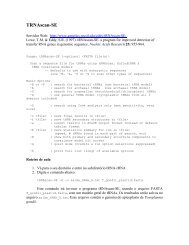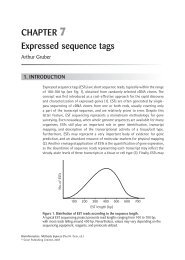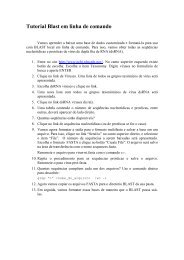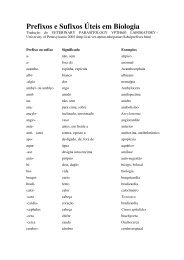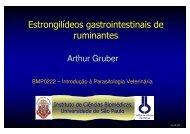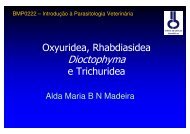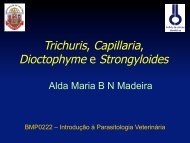Tutorial 1 - Coccidia.icb.usp.br
Tutorial 1 - Coccidia.icb.usp.br
Tutorial 1 - Coccidia.icb.usp.br
Create successful ePaper yourself
Turn your PDF publications into a flip-book with our unique Google optimized e-Paper software.
1<<strong>br</strong> />
<strong>Tutorial</strong> 1<<strong>br</strong> />
Reconstruction of a gene or genomic segment using a nucleotide or protein<<strong>br</strong> />
sequence seed<<strong>br</strong> />
In this tutorial, we describe how to run GenSeed to reconstruct a genomic segment<<strong>br</strong> />
containing several genes. For this purpose, we will use either a nucleotide or a protein<<strong>br</strong> />
sequence seed of glyceraldehyde 3-phosphate dehydrogenase (GAPDH) of<<strong>br</strong> />
Campylobacter jejuni.<<strong>br</strong> />
1. Seed sequence<<strong>br</strong> />
The seed directory contains four files:<<strong>br</strong> />
• GAPDH_nt_seed.fasta – a 140-bp nucleotide sequence of the GAPDH gene<<strong>br</strong> />
(accession code AL111168, region 1337856-1337995).<<strong>br</strong> />
• GAPDH_prot_seed.fasta – a 25-aa protein sequence fragment of the<<strong>br</strong> />
GAPDH.<<strong>br</strong> />
2. Database<<strong>br</strong> />
We will use a database of shotgun reads of Campylobacter jejuni NCTC 11168 genome.<<strong>br</strong> />
For this tutorial, we are providing a copy of the database at /tutorial_1/db/. You<<strong>br</strong> />
can also download the original file from<<strong>br</strong> />
ftp://ftp.sanger.ac.uk/pub/pathogens/cj/CJ_shotgun.dbs.gz (09-02-2000).<<strong>br</strong> />
3. Running GenSeed<<strong>br</strong> />
A comprehensive explanation on all GenSeed parameters is depicted in “GenSeed -<<strong>br</strong> />
Quick Guide” document. Please refer to it if you need more information.<<strong>br</strong> />
To run GenSeed, first go to the /tutorial_1/test directory, and then type the<<strong>br</strong> />
following command:<<strong>br</strong> />
genseed.pl –s ../seed/GAPDH_nt_seed.fasta –d ../db/CJ_shotgun.dbs -o<<strong>br</strong> />
output_nt -r 5<<strong>br</strong> />
4. Understanding GenSeed parameters:<<strong>br</strong> />
A comprehensive explanation on all GenSeed parameters is depicted in “GenSeed -<<strong>br</strong> />
Quick Guide” document. Please refer to it if you need more information.<<strong>br</strong> />
Shortly, the command line used above specifies the following parameters:<<strong>br</strong> />
• –s ../seed/GAPDH_nt.fasta - seed sequence file with path<<strong>br</strong> />
• –d ../db/CJ_shotgun.dbs - database file with path
2<<strong>br</strong> />
• –o output_nt - output_nt as the output directory name<<strong>br</strong> />
• -r 5 – use five walking rounds<<strong>br</strong> />
Please notice that in this example we are using a nucleotide sequence seed. At the<<strong>br</strong> />
end of this tutorial we will perform a second reconstruction using a protein seed<<strong>br</strong> />
(GAPDH_prot.fasta file).<<strong>br</strong> />
5. Understanding GenSeed output files:<<strong>br</strong> />
If everything goes well, a new subdirectory will be created:<<strong>br</strong> />
output_nt<<strong>br</strong> />
Also, a log file (genseed.log) will be created in the<<strong>br</strong> />
/tutorial_1/test/output_nt directory. This is a text file that displays all steps<<strong>br</strong> />
followed by GenSeed. In case of an error, you should expect to find the corresponding<<strong>br</strong> />
error message in this file. Inspect the file using any text editor/viewer. It should present<<strong>br</strong> />
the following content:<<strong>br</strong> />
Fri Nov 16 16:11:25 BRST 2007<<strong>br</strong> />
genseed.pl -s ../seed/GAPDH_nt_seed.fasta -d ../db/CJ_shotgun.dbs -o<<strong>br</strong> />
output_nt -r 5<<strong>br</strong> />
seed type: DNA<<strong>br</strong> />
#### Round 1 ####<<strong>br</strong> />
Total # of reads for CAP3: 4<<strong>br</strong> />
Length of the seed-contig C_jenuni: 755<<strong>br</strong> />
Accumulative number of reads: 4<<strong>br</strong> />
#### Round 2 ####<<strong>br</strong> />
Total # of reads for CAP3: 15<<strong>br</strong> />
Length of the seed-contig C_jenuni: 1739<<strong>br</strong> />
Accumulative number of reads: 19<<strong>br</strong> />
#### Round 3 ####<<strong>br</strong> />
Total # of reads for CAP3: 13<<strong>br</strong> />
Length of the seed-contig C_jenuni: 2813<<strong>br</strong> />
Accumulative number of reads: 32<<strong>br</strong> />
#### Round 4 ####<<strong>br</strong> />
Total # of reads for CAP3: 22<<strong>br</strong> />
Length of the seed-contig C_jenuni: 3756<<strong>br</strong> />
Accumulative number of reads: 54<<strong>br</strong> />
#### Round 5 ####<<strong>br</strong> />
Total # of reads for CAP3: 13<<strong>br</strong> />
Length of the seed-contig C_jenuni: 4928<<strong>br</strong> />
Accumulative number of reads: 67<<strong>br</strong> />
#### Last Round ####<<strong>br</strong> />
Length of the final seed-positive contig C_jejuni: 4928<<strong>br</strong> />
According to this file, GenSeed ran four rounds, as chosen by the parameter –r 5. In<<strong>br</strong> />
total, 67 reads were used for the final assembly step. No errors were reported. To see<<strong>br</strong> />
the results, go to the output_nt directory, where you will find the following<<strong>br</strong> />
directories…
3<<strong>br</strong> />
BLAST_dir<<strong>br</strong> />
CAP3_dir<<strong>br</strong> />
fasta_dir<<strong>br</strong> />
image_dir<<strong>br</strong> />
…and files:<<strong>br</strong> />
final_contigs.fasta<<strong>br</strong> />
list_of_reads.html<<strong>br</strong> />
report.html<<strong>br</strong> />
seed_contigs.html<<strong>br</strong> />
Let’s know understand all output files and directories created by GenSeed:<<strong>br</strong> />
• genseed.log – This file is created by GenSeed on every run. If a file already<<strong>br</strong> />
exists, GenSeed appends the information of the new run.<<strong>br</strong> />
• output_nt – This is the directory that contains all output files stored by<<strong>br</strong> />
GenSeed. It contains several files and subdirectories as follows:<<strong>br</strong> />
CAP3_dir – This directory contains CAP3 input and output files of all<<strong>br</strong> />
rounds, plus the final assembly files.<<strong>br</strong> />
BLAST_dir – This directory contains BLAST output files produced in each<<strong>br</strong> />
round. Files typically are named as blast_1.out, blast_2.out, etc.<<strong>br</strong> />
fasta_dir - This directory contains all seed sequences used as inputs for<<strong>br</strong> />
BLAST searches in all rounds. At the first round the user provides the seed<<strong>br</strong> />
sequence(s) to be used. After the first round, GenSeed automatically extracts<<strong>br</strong> />
the ends from the assembled sequence and then use them as seeds in the<<strong>br</strong> />
subsequent round. Seed sequences are named seed_1.fasta,<<strong>br</strong> />
seed_2.fasta, etc. A second set of files is composed by the assembled<<strong>br</strong> />
consensus sequences of each round (consensus_1.fasta,<<strong>br</strong> />
consensus_2.fasta, etc.). The consensus sequences correspond to contig<<strong>br</strong> />
sequences assembled by CAP3 in each round. The final assembled sequence<<strong>br</strong> />
(final_reads.fasta) contains all the reads selected in all rounds.<<strong>br</strong> />
report.html – This file contains the information on the size of the<<strong>br</strong> />
contig(s), number of reads included in the last assembly step, and graphical<<strong>br</strong> />
outputs that display the assembly of each walking cycle. The bitmap *.png<<strong>br</strong> />
files are stored in the image_dir directory. The series of screenshots below<<strong>br</strong> />
show the graphical outputs obtained for the dataset of the current tutorial.
seed_contigs.html – This file contains the consensus sequence(s)<<strong>br</strong> />
obtained in each round.<<strong>br</strong> />
5
6<<strong>br</strong> />
<<strong>br</strong> />
list_of_reads.html – This file contains a list of names of the reads<<strong>br</strong> />
incorporated in each round.
7<<strong>br</strong> />
<<strong>br</strong> />
final_contigs.fasta – This file contains the final consensus sequence<<strong>br</strong> />
assembled sequence(s) obtained by GenSeed. In this dataset we should<<strong>br</strong> />
obtain a sequence containing 4,928 bp. If you use this sequence to perform<<strong>br</strong> />
BLAST searches against the annotated genome of C. jejuni, you will find<<strong>br</strong> />
that the reconstructed region covered in total six full-length protein-coding<<strong>br</strong> />
genes (accession codes NP_282542 to NP_282547), including the GAPDH.<<strong>br</strong> />
6. Making a unidirectional progressive assembly<<strong>br</strong> />
GenSeed can perform progressive assemblies in both directions of the seed, as we have<<strong>br</strong> />
done so far. However, the program also permits the user to choose a 5’ or 3’ direction,<<strong>br</strong> />
such that the assembly process proceeds unidirectionally. To test this feature, please go<<strong>br</strong> />
to the /tutorial_1/test directory, and then type the following command:<<strong>br</strong> />
genseed.pl –s ../seed/GAPDH_nt_seed.fasta –d ../db/CJ_shotgun.dbs -o<<strong>br</strong> />
output_nt_l -r 5 –e l<<strong>br</strong> />
The –e (expansion) parameter defines the walking direction, which in this case is 5’ or<<strong>br</strong> />
left (l).<<strong>br</strong> />
According to genseed.log file, the sequence was grown in an average of 600 bp per<<strong>br</strong> />
cycle (3,017 bp divided by 5 cycles). Compare this growing performance with the one<<strong>br</strong> />
obtained in the previous step, using a bidirectional expansion. In fact, the bidirectional<<strong>br</strong> />
walking process resulted in a growing speed of almost 1 kb per cycle.<<strong>br</strong> />
seed type: DNA<<strong>br</strong> />
#### Round 1 ####<<strong>br</strong> />
Total # of reads for CAP3: 4<<strong>br</strong> />
Length of the seed-contig C_jenuni: 755<<strong>br</strong> />
Accumulative number of reads: 4<<strong>br</strong> />
#### Round 2 ####<<strong>br</strong> />
Total # of reads for CAP3: 10<<strong>br</strong> />
Length of the seed-contig C_jenuni: 1583<<strong>br</strong> />
Accumulative number of reads: 14<<strong>br</strong> />
#### Round 3 ####<<strong>br</strong> />
Total # of reads for CAP3: 8<<strong>br</strong> />
Length of the seed-contig C_jenuni: 2057<<strong>br</strong> />
Accumulative number of reads: 22<<strong>br</strong> />
#### Round 4 ####<<strong>br</strong> />
Total # of reads for CAP3: 7<<strong>br</strong> />
Length of the seed-contig C_jenuni: 2471<<strong>br</strong> />
Accumulative number of reads: 29<<strong>br</strong> />
#### Round 5 ####<<strong>br</strong> />
Total # of reads for CAP3: 7<<strong>br</strong> />
Length of the seed-contig C_jenuni: 3017<<strong>br</strong> />
Accumulative number of reads: 34<<strong>br</strong> />
#### Last Round ####<<strong>br</strong> />
Length of the final seed-positive contig C_jejuni: 2883
8<<strong>br</strong> />
Now open the report.html file and compare the walking process with the<<strong>br</strong> />
bidirectional process executed in the previous step. Run a BLAST search of the final<<strong>br</strong> />
reconstructed sequence against the annotated genome of C. jejuni. Now inspect which<<strong>br</strong> />
genes were reconstructed compared to the bidirectional assembly.<<strong>br</strong> />
7. Limiting the walking process by size<<strong>br</strong> />
In the former steps we have reconstructed a 4,298-bp segment of C. jejuni genome by<<strong>br</strong> />
limiting the reconstruction process to five walking cycles (-r parameter). We will now<<strong>br</strong> />
re-run the program with the same seed and database, but this time limiting the<<strong>br</strong> />
reconstruction according to the length of the reconstructed fragment. We will use the<<strong>br</strong> />
parameter –f 5000 to limit the walking process to 5 kb.<<strong>br</strong> />
Go to the /tutorial_1/test directory, and then type the following command:<<strong>br</strong> />
genseed.pl –s ../seed/GAPDH_nt_seed.fasta –d ../db/CJ_shotgun.dbs -o<<strong>br</strong> />
output_nt_5kb -f 5000<<strong>br</strong> />
According to genseed.log file, six rounds were performed, until contig of round #6<<strong>br</strong> />
reached 5,733 bp. At this moment, the program stopped the walking cycling and ran the<<strong>br</strong> />
final assembly phase, resulting in a final reconstructed sequence of 5,732 bp (see<<strong>br</strong> />
final_contigs.fasta file). Please notice that 5 kb was just an upper limit for the<<strong>br</strong> />
program to know when to stop the walking process. The final contig length is slightly<<strong>br</strong> />
longer than this value.
9<<strong>br</strong> />
seed type: Protein<<strong>br</strong> />
#### Round 1 ####<<strong>br</strong> />
Total # of reads for CAP3: 4<<strong>br</strong> />
Length of the seed-contig C_jejuni: 755<<strong>br</strong> />
Accumulative number of reads: 4<<strong>br</strong> />
#### Round 2 ####<<strong>br</strong> />
Total # of reads for CAP3: 15<<strong>br</strong> />
Length of the seed-contig C_jejuni: 1739<<strong>br</strong> />
Accumulative number of reads: 19<<strong>br</strong> />
#### Round 3 ####<<strong>br</strong> />
Total # of reads for CAP3: 13<<strong>br</strong> />
Length of the seed-contig C_jejuni: 2813<<strong>br</strong> />
Accumulative number of reads: 32<<strong>br</strong> />
#### Round 4 ####<<strong>br</strong> />
Total # of reads for CAP3: 22<<strong>br</strong> />
Length of the seed-contig C_jejuni: 3756<<strong>br</strong> />
Accumulative number of reads: 54<<strong>br</strong> />
#### Round 5 ####<<strong>br</strong> />
Total # of reads for CAP3: 13<<strong>br</strong> />
Length of the seed-contig C_jejuni: 4928<<strong>br</strong> />
Accumulative number of reads: 67<<strong>br</strong> />
#### Round 6 ####<<strong>br</strong> />
Total # of reads for CAP3: 21<<strong>br</strong> />
Length of the seed-contig C_jejuni: 5733<<strong>br</strong> />
Accumulative number of reads: 88<<strong>br</strong> />
A contig reached the maximum number of bases!<<strong>br</strong> />
#### Last Round ####<<strong>br</strong> />
Length of the final seed-positive contig C_jejuni: 5732<<strong>br</strong> />
8. Running GenSeed with a protein sequence seed<<strong>br</strong> />
This time we will run GenSeed against the same database, but using a protein<<strong>br</strong> />
sequence seed of the same GAPDH gene. To run GenSeed, first go to the<<strong>br</strong> />
/tutorial_1/test directory, and then type the following command:<<strong>br</strong> />
genseed.pl –s ../seed/GAPDH_prot_seed.fasta –d ../db/CJ_shotgun.dbs<<strong>br</strong> />
-o output_prot -r 5<<strong>br</strong> />
You should now find a newly created output_prot subdirectory.<<strong>br</strong> />
Start inspecting the log file (genseed.log). You will see that GenSeed has<<strong>br</strong> />
appended new information on the previously existing file. This new information should<<strong>br</strong> />
like as follows:
10<<strong>br</strong> />
Fri Nov 16 16:51:10 BRST 2007<<strong>br</strong> />
genseed.pl -s ../seed/GAPDH_prot_seed.fasta –d ../db/CJ_shotgun.dbs<<strong>br</strong> />
-o output_prot -r 5<<strong>br</strong> />
seed type: Protein<<strong>br</strong> />
#### Round 1 ####<<strong>br</strong> />
Total # of reads for CAP3: 4<<strong>br</strong> />
Length of the seed-contig C_jenuni: 755<<strong>br</strong> />
Accumulative number of reads: 4<<strong>br</strong> />
#### Round 2 ####<<strong>br</strong> />
Total # of reads for CAP3: 15<<strong>br</strong> />
Length of the seed-contig C_jenuni: 1739<<strong>br</strong> />
Accumulative number of reads: 19<<strong>br</strong> />
#### Round 3 ####<<strong>br</strong> />
Total # of reads for CAP3: 13<<strong>br</strong> />
Length of the seed-contig C_jenuni: 2813<<strong>br</strong> />
Accumulative number of reads: 32<<strong>br</strong> />
#### Round 4 ####<<strong>br</strong> />
Total # of reads for CAP3: 22<<strong>br</strong> />
Length of the seed-contig C_jenuni: 3756<<strong>br</strong> />
Accumulative number of reads: 54<<strong>br</strong> />
#### Round 5 ####<<strong>br</strong> />
Total # of reads for CAP3: 13<<strong>br</strong> />
Length of the seed-contig C_jenuni: 4928<<strong>br</strong> />
Accumulative number of reads: 67<<strong>br</strong> />
#### Last Round ####<<strong>br</strong> />
Length of the final seed-positive contig C_jenuni: 4928<<strong>br</strong> />
Compare this information with the reconstruction performed with the DNA seed. You<<strong>br</strong> />
will see that both reconstructions were almost identical in respect to the size of the<<strong>br</strong> />
contig and the number of composing reads. Check the report files and compare the<<strong>br</strong> />
results.<<strong>br</strong> />
© 2007. Tiago J. P. So<strong>br</strong>eira and Arthur Gruber



